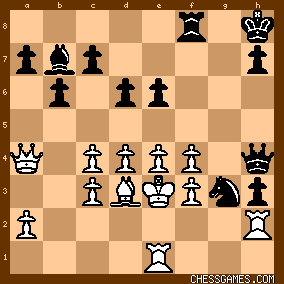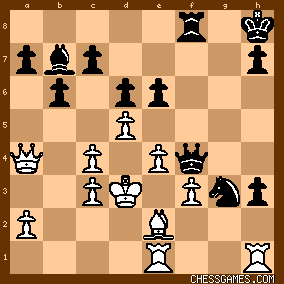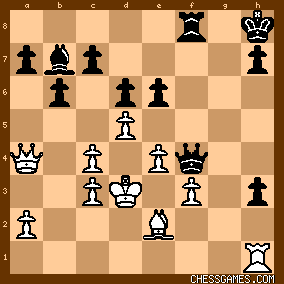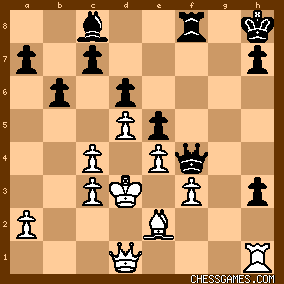Jul-17-16
 | | An Englishman: Good Evening: Still wondering why White played 16.g3 and 17.h4. As for the position itself, wasn't very hard for a Sunday--once you see that the critical square is f4, Black's plan of attack becomes obvious, even if you can't analyze every line until the very end. |
|
Jul-17-16
 | | Penguincw: DAMN! Look at that wall of pawns surrounding the white king. Let's see: white has a rook for knight.
My first instinct was to win the exchange with 31...Nxh1, but after 32.Rxh1, material is only balanced, and when comparing king safety, white's king looks a lot more safer despite being in the middle of the board. And since it's a Sunday puzzle, I knew it wouldn't be that kind of move. Besides, black just gave up the exchange on move 23; would be pointless to take it right back. I did not get it, but lines I considered included 25...Nf5+ 26.exf5 exf5+, but 26.Kd2, now what? 25...d5 can be met with 26.e5 or 26.Rxh3.
Final position actually has white's king exposed, and of course if the queen moves (ex. 32.Qxc7) then 32...Qf4# 0-1. Can't wait for tomorrow's Monday puzzle. |
|
Jul-17-16
 | | al wazir: I don't understand this game. At all. |
|
| Jul-17-16 | | sudoplatov: I got ...Qh4 but I didn't consider Qb5; I expected Qd7 and the game position arises with White to move after ...e5. |
|
| Jul-17-16 | | drollere: black is down the exchange but has an advanced and undefended KR pawn and has just forked the white KR with a knight check. the immediate issues are to capture the rook and protect the pawn. the white K is well protected, but Qh4 and Nh5 protect the pawn long enough for Qxf4+, followed by Rg8. but white Rg1 then Rg4 prevents that. if the pawn is actually lost, then attack the king. e4 looks vulnerable but how to attack it? d5 or dxe5 may open a diagonal for a queen check at c5 or g5, but unless forced otherwise white's next move is Rxh3. so: 23. ... e5
24. Rxh3 exf4+
or 23. ... e5
24. f5 Qg5+
or 23. ... e5
24. dxe5 dxe5
25. f5 Qg5+
with for example:
26. Kf2 Qd2+
27. Kxg3 Rg8+
28. Kxh3 Qh2+ etc.
i did not grasp that d5 also permits Qf4+ after Qh4, and the N blocks a possible Rg4. the check at 26 can be blocked by Re2 or Be2, countered by either Nxh1+ or Nxe4+. in the game, Qb5 seems a blunder, since the rank is blocked by e5 and the Q can only continue to d7. but Qd7 rather than dxe5 seems even worse: white has a check if black plays dxe5, and now R(e)g1 works to pin the N. |
|
| Jul-17-16 | | schachfuchs: Yes,I think 26.Qb5 is a really useless time loss, there must be better defences for black. This made me also think 25...Qh4 would be too slow. |
|
| Jul-17-16 | | YouRang: Insane Sunday 25...?

click for larger view My first thought was 25...Nxh1, but (as <Penguincw> pointed out), it's boring. Then, I considered that the weakest point around the white K is Pf4, so I actually did consider <25...Qh4> with the idea of (1) protecting my Ph3 and (2) building attack on Pf4 with ...Rf8. Now, how does white respond? I figured maybe <26.Rh2> to get the Rh1 out of take. Now the planned <26...Rf8> and I have a nice attack going.

click for larger view ~~~~
I checked this with the engine and discovered that this position is a whole lot weirder than I imagined. For example:
- white's best reply to 25...Qh4 is 26.Rxh3.
- if white plays 26.Ra2, black's best is 26...Nf5+
- if 26.Ra2 Rf8 27.Kd2, black's best is 27...Nxe4.
I wouldn't have guessed any of these moves. When Tal famously said <"You must take your opponent into a deep dark forest where 2+2=5, and the path leading out is only wide enough for one.">, he was talking about this position. Good puzzle for promoting insanity. :-\ |
|
| Jul-17-16 | | diagonalley: <al wazir> ... me too (as usual) |
|
Jul-17-16
 | | offramp: At move 25 the white king looks to be in a Fort Knox-like quebec, or a Quebec-like Fort Knox. The game reminds me a little of Janowski vs Lasker, 1909, where this position occurs: 
click for larger view which Black showed to be very bad for White! Despite his abbatis and caltrops, White's fortress was soon subject to an avant-fosse, causing a complete goo-gah. |
|
| Jul-17-16 | | mel gibson: I didn't see it.
DR4 64 bit agrees with the first move:
(25. .. Qh4
{(Qe7-h4 Rh1xh3 Qh4xh3 Qa4-d7 Ra8-f8 Qd7xc7 Qh3-h4 Qc7xd6 Ng3-f5+ e4xf5
Qh4xe1+ Bd3-e2 Qe1-c1+ Ke3-f2 Rf8-g8 Qd6-e5+ Rg8-g7 Qe5-b8+ Bb7-c8 Be2-f1
Qc1-b2+ Bf1-e2 Qb2-a1 Be2-f1 Qa1xc3 Qb8xc8+ Rg7-g8 Qc8xe6 Qc3-d2+ Bf1-e2
Qd2xd4+)
But as can be seen the order of moves changes.
The score is +1.55 to Black. Depth 18. |
|
| Jul-17-16 | | morfishine: <offramp> I saw this game somewhere, but don't recall where. Thanks for the link to Janowski vs Lasker Janowski vs Lasker, 1909 I've seen that game to, but also don't remember where. Perhaps I should go back to bed and catch another hour or two ***** |
|
| Jul-17-16 | | thegoodanarchist: not even close today... |
|
| Jul-17-16 | | YouRang: <An Englishman: Good Evening: Still wondering why White played 16.g3 and 17.h4.> Those move do look a bit counter-intuitive, but I think it was probably white's intent to open up the g-file to launch a kingside attack, with the idea taking his king to the "safety" of his central pawns. It was ill-advised since black ends up with the passed h-pawn, and the open g-file was seized first by black. Even so, checking with the engine, it seems that white's plan really wasn't *that* bad until he played <25.Ke3?> (25.Kd1 was best). Then, white missed the significance of <25...Qh4> attacking Pf4 by playing <26.Qb5?>, and it was all over. |
|
| Jul-17-16 | | Patriot: I had some of the right ideas but didn't put them together in the right way. I looked at 25...Nf5+ but 26.exf5 isn't forced, even though it is best. It's unclear how to proceed if white simply dodges the bullet and he also looks better materially. Next was 25...Nxh1 26.Rxh1 Qh4. A few candidates were Qd7 and Bf1. These are moves that attempt to counter black and strive to improve his own position, since material is even. While looking at this, I also questioned 25...Qh4 as a potentially easier candidate. On 27.Qd7, I thought 27...Rg8 might be best. On 27.Bf1, which I considered a bit more, 27...e5 28.Rxh3 Qxf4+ 29.Ke2 and wasn't quite sure how to proceed although I felt that black was doing ok. On 25...Qh4, I don't recall if I thought about the ...e5 idea here. The computer recommends 26.Rxh3 here with counter-play on d7. This seems more counter-intuitive than anything, to even consider such a move, unless you really think you can drum up trouble. Otherwise something is wrong your thinking process to waste time on such moves. |
|
| Jul-17-16 | | shepi13: I haven't checked any of my ideas with an engine, so they might be completely wrong. Qh4 looked very strong to me at first glance, and I couldn't find a way for white to defend against the coming Rf8 with an enormous attack. If Rh2 as <YouRang> suggested, then Nf5+ is a discovered attack on e1 and Ke2 Qxf4 (hitting h2) must be very strong, so I only considered Rg1 Rf8 when white's position looks terrible, or Rf1 giving back the exchange to try to defend f3 somehow. Qb5 is a nice move, intending to meet Rf8 with Qg5 (if Qd7 immediately I think black should play Rf8, some people have said e5 reaches the same position with white to move but white can just play something like Qg4 and be safe), and e5! is a brilliant response, preventing all of white's defensive ideas and opening lines for black to attack. Very nice game by Howell. I don't understand Qh4 Rxh3, but it's probably some computer line where white gets some pawns for the piece somehow. |
|
Jul-17-16
 | | Jimfromprovidence: I was wondering if anyone analyzed after 25...Qh4, 26 Be2?! (creating an escape square), seeing 26...Rf8 27 d5 Qxf4+ 28 Kd3.
click for larger view |
|
| Jul-17-16 | | lost in space: I was wondering the same about 25...Qh4 26. d5 Rf8 27. Be2 Qxf4 28. Kd3 
click for larger viewor even 27...Nxh1 28. Rxh1 Qxf4 29. Kd3

click for larger view |
|
| Jul-17-16 | | lost in space: Clear black advantage is all I can see, not more |
|
| Jul-17-16 | | WorstPlayerEver: 25... Qh4 26. d5 Rf8 27. Be2 Qf4 28. Kd3 Bc8 29. Rh3 ed5 30. Rg3 de4 31. fe4 Qg3 32. Kd2 Qf4 33. Kd1 Qe4 |
|
| Jul-17-16 | | shepi13: I can't see the white king surviving after 28...Nxe2 29. Kxe2 Qxf3+ 30. Kd2 in those Be2 lines but I don't see a clear win. Also, d5 is hanging, black can consider 28... exd5 29. cxd5 Bxd5 but I'm still not sure where the crushing blow is in that line either. Probably I would play the Nxe2 line and after 30. Kd2 play something like 30...Qg2+ 31. Kd1/Kc1 Qg3, attacking c3 and if your queen goes back to defend it I play 32...Rf2 or 32...Rf3 now that Qe8 isn't possible. In any case, black looks significantly better. |
|
| Jul-17-16 | | agb2002: Black has a knight for a rook.
White threatens 26.Rxh3.
I don't know. I think I'd play 25... Nxh1 26.Rxh1 Qh4 and if 27.Qd7 then 27... Rf8 28.f5 exf5 seems to win a pawn at least (29.exf5 Qg5+ wins the rook). |
|
| Jul-17-16 | | leRevenant: <diagonalley: <al wazir> ... me too (as usual)>
me three |
|
| Jul-17-16 | | YouRang: <shepi13><If Rh2 as <YouRang> suggested, then Nf5+ is a discovered attack on e1 and Ke2 Qxf4 (hitting h2) must be very strong> Yeah, I noticed that after I posted. For some reason, I had the idea in my head that the Re1 was still guarded... |
|
| Jul-18-16 | | YouRang: <Jimfromprovidence: I was wondering if anyone analyzed after 25...Qh4, 26 Be2?! (creating an escape square), seeing 26...Rf8 27 d5 Qxf4+ 28 Kd3.>

click for larger view
Black has 28...Nxh1 or 28...Bc8.
I rather like <28...Bc8>, which suffices to guard Ph3, even though it is blocked since 29.Rxh3 exd5 threatens both the rook and to destroy the king's defense. Also, white can do little to save the Ra1 (e.g. 29.Rg1 h2!  ). White's best may be <29.Qd1> (to guard against ...Nxb2 and ...Qxf3+ ). White's best may be <29.Qd1> (to guard against ...Nxb2 and ...Qxf3+  ). But then, <29...Nxh1 30.Rxh1 e5!> ). But then, <29...Nxh1 30.Rxh1 e5!>

click for larger view
The passed Ph3 is guarded, and ...Rg8 is threatened. Perhaps Qf1 and sac the rook for the Ph3 and bishop, and black is just winning. |
|
| Jul-19-16 | | Moszkowski012273: Well played! |
|





